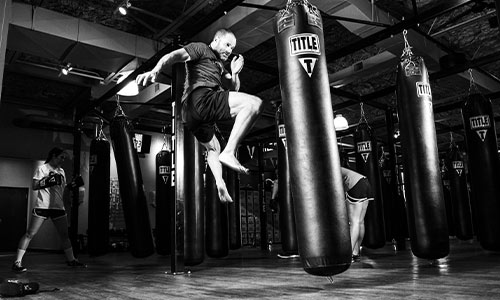The Question of Training to Failure
Author

Chris shares his passion for cycling, hiking, skiing, and climbing from Buxton, in the Peak District. As a blogger for Outdoor Look, Chris shares outdoor tips and indoor tricks to help you get the most out of your time spent outside. When he's not out adventuring he's making videos or trying to keep up with his 4-year-old son.
The concept of failure in training is often misunderstood and misapplied. People often expect amazing results from their workouts, but there are various reasons why they may not see those results.
When I first started lifting weights, I believed that pushing myself to failure was the ultimate goal. Looking at how Arnold Schwarzenegger trained and the culture of bodybuilding, failure seemed to be the desired outcome during my workouts. This mentality of viewing resistance exercise in absolute terms stayed with me for years. I believed that unless I felt like a failure with my muscles and needed a spotter to save me from being crushed by a barbell, my workouts were not successful.
However, I've come to realize that pushing your muscles to the point where you can't lift a weight is not the purpose of working out. While increasing muscle mass is important, it's also crucial to prioritize overall health and see amazing results through a well-rounded workout routine and disciplined lifestyle.

Is Training to Failure Necessary for Muscle Growth?
It's widely understood that hypertrophy is crucial for improving physique and performance among strength athletes. Training to failure may activate a large number of motor units and potentially enhance muscle hypertrophy, as suggested by Willardson et al., who have produced high-quality literature on failure-based training. This method can indeed contribute to muscle growth.
However, Willardson also cautions against repeatedly training to failure over an extended period due to the risk of overuse injuries and overtraining. The lifter's training status and goals should guide the decision-making process throughout their training journey.
Breaking the 90 Percent Max Rule
An important factor in training to failure is the effective progression that turns failure into a success story over time. Intensity refers to the percentage of weight lifted in relation to an individual's one-repetition maximum (1-RM). Training to failure with heavy weights may not significantly enhance hypertrophy and could even impede strength gains. When aiming for failure, it's best to avoid exercises like squats, bench presses, and deadlifts.
How Often Should You Be Training to Failure?

Different categories can determine a trainee's current level, and their training methods may vary depending on whether they are beginners, intermediates, or advanced individuals. If you're a beginner or have been training for less than two years, it's advisable not to push yourself to muscle failure. Instead, aim for a level of fatigue just below failure. For example, set a goal rep range, such as 8 reps, and ensure you have one extra rep in reserve to avoid burnout.
It's important to choose what you want to work against to gain strength and stop guessing. Start living a healthier lifestyle with a more informed approach to training.
-
 Trespass Vatura Drinks Hydration Water Bottle£5.15RRP £16.00 Save Up To £10.85
Trespass Vatura Drinks Hydration Water Bottle£5.15RRP £16.00 Save Up To £10.85
Author

Chris shares his passion for cycling, hiking, skiing, and climbing from Buxton, in the Peak District. As a blogger for Outdoor Look, Chris shares outdoor tips and indoor tricks to help you get the most out of your time spent outside. When he's not out adventuring he's making videos or trying to keep up with his 4-year-old son.
- Speed Up Your Post-Hike Recovery with These 6 Essential Tips
- Cycling through Tranquil Roads and Coastal Views on the Isle of Wight
- The Essential Guide to Hiking Safety: 5 Tips Every Hiker Should Know
- Run Smart, Run Strong: Your Guide to Injury-Free Running
- Embrace Biking: Essential Tips for Beginners
Categories
- Sport (28)
- Product Reviews (3)
- Team Outdoor Look (7)
- Mike Wild (2)
- Mike Payton (2)
- Suse Hammond-Pears (3)
- Snowboarding (12)
- Latest Offers (105)
- Shop Talk (1)
- Competitions (7)
- Walking (413)
- Lifestyle Fashion (8)
- Travel (86)
- Kit Guides (176)
- Workwear Clothing (6)
- Safety Workwear (4)
- Health/Fitness (289)
- Skiing (91)
- Great Outdoors (1316)
- Cycling (92)
- January 2025
- December 2024
- November 2024
- October 2024
- September 2024
- August 2024
- July 2024
- June 2024
- May 2024
- April 2024
- March 2024
- February 2024
- January 2024
- December 2023
- November 2023
- October 2023
- September 2023
- August 2023
- July 2023
- June 2023
- May 2023
- April 2023
- March 2023
- February 2023
- January 2023
- December 2022
- November 2022
- October 2022
- September 2022
- August 2022
- July 2022
- June 2022
- May 2022
- April 2022
- March 2022
- February 2022
- January 2022
- December 2021
- November 2021
- October 2021
- September 2021
- August 2021
- July 2021
- June 2021
- May 2021
- April 2021
- March 2021
- February 2021
- January 2021
- December 2020
- November 2020
- October 2020
- September 2020
- August 2020
- July 2020
- June 2020
- May 2020
- April 2020
- March 2020
- February 2020
- January 2020
- December 2019
- November 2019
- October 2019
- September 2019
- August 2019
- July 2019
- June 2019
- May 2019
- April 2019
- March 2019
- February 2019
- January 2019
- December 2018
- November 2018
- October 2018
- September 2018
- August 2018
- July 2018
- June 2018
- May 2018
- April 2018
- March 2018
- February 2018
- January 2018
- December 2017
- November 2017
- October 2017
- September 2017
- August 2017
- July 2017
- June 2017
- May 2017
- April 2017
- March 2017
- February 2017
- January 2017
- December 2016
- November 2016
- October 2016
- September 2016
- August 2016
- July 2016
- June 2016
- May 2016
- April 2016
- March 2016
- February 2016
- January 2016
- December 2015
- November 2015
- October 2015
- September 2015
- August 2015
- July 2015
- June 2015
- May 2015
- April 2015
- March 2015
- February 2015
- January 2015
- December 2014
- November 2014
- October 2014
- September 2014
- August 2014
- July 2014
- June 2014
- May 2014
- April 2014
- March 2014
- February 2014
- January 2014
- December 2013
- November 2013
- October 2013
- September 2013
- August 2013
- July 2013
- June 2013
- May 2013
- April 2013
- March 2013
- February 2013
- January 2013
- December 2012
- November 2012
- October 2012
- September 2012
- August 2012
- July 2012
- June 2012
- May 2012
- April 2012
- March 2012
- February 2012
- January 2012
- December 2011
- November 2011
- October 2011
- September 2011
- August 2011
- May 2010
- April 2010
- March 2010
- February 2010
- January 2010
- November 2009
- October 2009
- September 2009


Submit a Comment